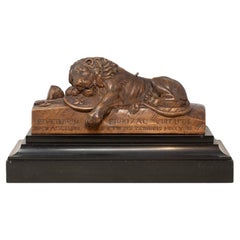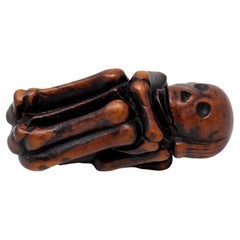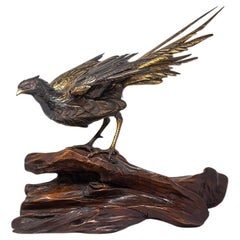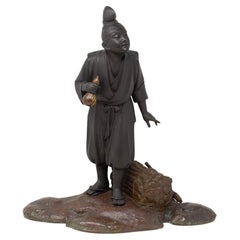Want more images or videos?
Request additional images or videos from the seller
1 of 21
Chinese Soapstone Carving and Stand
$9,910.78List Price
About the Item
- Dimensions:Height: 2.17 in (5.52 cm)Width: 7.48 in (19 cm)Depth: 8.66 in (22 cm)
- Style:Qing (Of the Period)
- Materials and Techniques:
- Place of Origin:
- Period:
- Date of Manufacture:circa 1880
- Condition:Minor losses.
- Seller Location:Newark, GB
- Reference Number:Seller: SWAPDD1stDibs: LU6971232629972
About the Seller
5.0
Gold Seller
Premium sellers maintaining a 4.3+ rating and 24-hour response times
Established in 2019
1stDibs seller since 2022
39 sales on 1stDibs
Typical response time: 2 hours
Authenticity Guarantee
In the unlikely event there’s an issue with an item’s authenticity, contact us within 1 year for a full refund. DetailsMoney-Back Guarantee
If your item is not as described, is damaged in transit, or does not arrive, contact us within 7 days for a full refund. Details24-Hour Cancellation
You have a 24-hour grace period in which to reconsider your purchase, with no questions asked.Vetted Professional Sellers
Our world-class sellers must adhere to strict standards for service and quality, maintaining the integrity of our listings.Price-Match Guarantee
If you find that a seller listed the same item for a lower price elsewhere, we’ll match it.Trusted Global Delivery
Our best-in-class carrier network provides specialized shipping options worldwide, including custom delivery.You May Also Like
Chinese Soapstone Fish Carving 20th Century
Located in Islamabad, PK
Chinese Soapstone fish carving 20th century.
This exquisite soapstone sculpture is a unique carving, as it shows to us the natural formation of two stones with the grey soapstone accompanied by the red, yellow and beige soapstone carved into a beautiful depiction of fish and and underwater coral.
Shoushan stone...
Category
20th Century Chinese Ming Figurative Sculptures
Materials
Soapstone
Chinese Soapstone Carving Running Horses, Mid-20th Century
Located in Islamabad, PK
Chinese soapstone carving running horses, Mid-20th Century.
The large magnificent soapstone carving is depicting running horses beautifully carved in the natural soapstone placed on a wooden root branch. Galloping horses in Chinese culture symbolize upwardly movement which could mean a promotion or growth in career
Shoushan stone...
Category
Mid-20th Century Chinese Sculptures and Carvings
Materials
Soapstone
20C Medium Chinese Soapstone Carving
Located in Dallas, TX
Presenting a lovely 20c medium Chinese soapstone carving.
Made in China in the early 20th century circa 1930.
This is a medium/tall gre...
Category
Early 20th Century Chinese Chinese Export Sculptures and Carvings
Materials
Soapstone
Large Qing Dynasty Chinese Soapstone Monkeys Group Carving
Located in Hoddesdon, GB
A rare large Chinese soapstone monkey group sculpture dating to the early 19th century, featuring seven intricately detailed monkeys scrambling over one another to reach a peach. The...
Category
Antique Early 19th Century Chinese Qing Sculptures and Carvings
Materials
Soapstone
large Chinese soapstone carving of Chinese carrots
Located in New York, NY
38in(H) x 16in(W) x 9in(D) are the overall dimensions of the carving including its carved wooden base
Category
Mid-20th Century Chinese Sculptures and Carvings
Materials
Soapstone
Carved Yellow Soapstone Figure of Guanyin, Chinese circa 1900
Located in Ottawa, Ontario
The finely carved full length figure of 'The Goddess of Compassion, Kindness & Mercy' shown attired in flowing robes, her hair worn in high chignon with her face effecting a serene a...
Category
Early 20th Century Chinese Qing Sculptures and Carvings
Materials
Soapstone
Chinese Chicken Blood Stone Carving of Bodhidharma on Wood Stand
Located in Atlanta, GA
A small chicken blood stone carving from China circa early 20th century, possibly early (late Qing to early Republic period). It depicts an aged Bo...
Category
Early 20th Century Chinese Chinese Export Sculptures and Carvings
Materials
Stone
20C Chinese Soapstone Foo Dog Carving
Located in Dallas, TX
Presenting a lovely 20C Chinese soapstone foo dog carving.
Made in China in the early 20th century circa 1930.
This is a small green and brown ...
Category
Early 20th Century Chinese Chinese Export Sculptures and Carvings
Materials
Soapstone
Monumental Chinese Buddhist Mountain Monastery Soapstone Carving, 20th Century
Located in Islamabad, PK
The Monumental Chinese Buddhist Mountain Monastery Soapstone Carving is a masterful work of art that encapsulates the grandeur and spiritual significance of Chinese Buddhist archite...
Category
Late 20th Century Chinese Qing Sculptures and Carvings
Materials
Soapstone
$4,500
H 25 in W 16 in D 7 in
Early 20thc Chinese Soapstone Carving of Flowers & Birds on Teakwood Stand
Located in Savannah, GA
This very lovely soapstone sculpture is intricately carved and features two vases and a smaller receptacle with three little birds intertwined in flowers and leaves. Some design etch...
Category
Vintage 1930s Chinese Chinese Export Sculptures and Carvings
Materials
Soapstone
$451 Sale Price
30% Off
H 12 in W 11 in D 4.5 in
More From This Seller
View AllAntique Swiss Black Forest Wood and Marble Lucerne Lion Carving
By Black Forest
Located in Newark, England
Mounted on a Black Marble Plinth
From our Black Forest collection, we are delighted to introduce this Swiss Black Forest Lucerne Lion Carving. The Lucern...
Category
Antique Late 19th Century Swiss Art Nouveau Animal Sculptures
Materials
Marble
Japanese Edo Period (1603-1868) Skeleton Foetus Netsuke
Located in Newark, England
Laying Foetus
From our Japanese collection, we are pleased to offer this Japanese Edo Period Skeleton Netsuke. The Skeleton Netsuke is carved from Boxwood depicting a skeleton in t...
Category
Antique Mid-19th Century Japanese Edo Sculptures and Carvings
Materials
Wood, Boxwood
Japanese Bronze Pheasant Okimono Genryusai Seiya
Located in Newark, England
Unusual Casting of a Pheasant in Flight
From our Japanese collection, we are delighted to offer this Japanese bronze okimono of a Pheasant upon a naturalistic root wood base. The Ph...
Category
Antique Late 19th Century Japanese Meiji Sculptures and Carvings
Materials
Bronze
Japanese Bronze Okimono Sculpture by Yamamoto Kozan
Located in Newark, England
YOUNG MAN WOOD CUTTING
From our Japanese collection, we are pleased to offer this Japanese Bronze Okimono by Yamamoto Kozan. The Japanese Bronze Sculpture cast in Bronze with a natu...
Category
Early 20th Century Japanese Meiji Sculptures and Carvings
Materials
Bronze
Japanese Meiji Period Bronze Monkey Group Sculpture Okimono Shosai
Located in Newark, England
Featuring Seven Japanese Macaques
Form our Japanese collection, we are delighted to offer this Japanese Bronze Monkey Group by Shosai. The Japanese Bronze Group displaying a male father monkey and his infants playing around and being mischievous with Persimmon fruit. The monkeys modelled as Japanese macaque monkeys (snow monkey). The bronze okimono is beautifully patinated with a highly lifelike and naturalistic casting signed to the underside Shosai 正齊鋳. The Bronze group dates to the Meiji Period (1868-1912) circa 1885.
Japanese macaque (snow monkey) is a terrestrial Old World monkey species that is native to Japan. They are known as snow monkeys because some live in areas where snow covers the ground for long periods each year hence their nickname. No other non-human primate lives further north or in a colder climate than the snow monkey. Individuals have brownish grey fur, pinkish-red faces, and short tails. Two subspecies are known and their conservation Status is of least concern. In Japan, the species is known as Nihonzaru ニホンザル, 日本 (Japan/Nihon) and saru 猿 (monkey) to distinguish it from other primates, but the Japanese macaque is the only species of monkey in Japan.
The Japanese macaque features heavily in the religion, folklore, and art of Japan, as well as in proverbs and idiomatic expressions in the Japanese language. They are often seen in paintings, block prints and represented in all manner of carvings from Okimono to netsuke. Many of these art forms reside in the world’s most famous museums and collections, some of the most prominent pieces by artists such as Mori Sosen and Kawanabe Kyosai. In Shinto belief (Japan’s indigenous religion/nature religion) legendary mythical beasts known as raiju sometimes appeared as monkeys and kept Raijin (the god of lightning/storms) company. In another well known tale the three wise monkeys who warn people to “see no evil, hear no evil and speak no evil” can be seen depicted in relief over the door of the famous Tosho-gu shrine in Nikko.
Meiji Period was an era of Japanese history that spanned from 1868 to 1912. It was the first half of the Empire of Japan, when the Japanese people began to build a paradigm of a modern, industrialised nation state and emergent great power, influenced by Western countries and aesthetics. As a result of radically different ideas, the changes to Japan were profound and it affected the social structure, politics, economy, military, and foreign relations across the board. The period corresponded to the reign of Emperor Meiji and was preceded by the Keio era and was succeeded by the Taisho era.
Cultural Art during the Meiji Period was of particular interest to the government and they overhauled the art export market which in turn promoted Japanese arts via various world’s fairs, beginning in Vienna at the world fair in 1873. The government heavily funded the fairs and took an active role organising how Japan’s culture was presented to the world including creating a semi-public company named Kiritsu Kosho Kaisha (First Industrial Manufacturing Company). The Kiritsu Kosho Kaisha was used to promote and commercialise exports of Japanese art and established the Hakurankai Jimukyoku (Exhibition Bureau) to maintain quality standards. For the 1876 Centennial International Exhibition in Philadelphia, the Japanese government created a Centennial Office and sent a special envoy to secure space for the 30,000 items that would be displayed. The Imperial Household also took an active interest in arts and crafts, commissioning works by select artists to be given as gifts for foreign dignitaries further emphasising the high quality and importance of Japanese art. Just before the end of the 19th century in 1890, the Teishitsu Gigeiin (Artist to the Imperial Household) system was created to recognise distinguished artists. These artists were selected for their exceptionally high quality wares and talent in their own industry. Over a period of 54 years Seventy artists were appointed, amongst these were ceramicist Makuzu Kozan and cloisonné enamel artist...
Category
Antique Late 19th Century Japanese Meiji Sculptures and Carvings
Materials
Bronze
China Man Bronze Tankard by Alfonso Canciani K. K. Kunst-Erzgiesserei
By Alfonso Canciani, K.K. Kunst-Erzgiesserei Wien
Located in Newark, England
Viennese Secession Orientalist Bronze
From our Sculpture collection, we are delighted to introduce this rare China Man Bronze Tankard by Alfonso Cancia...
Category
Antique Early 1900s Austrian Vienna Secession Figurative Sculptures
Materials
Bronze
Recently Viewed
View AllMore Ways To Browse
Antique Carved Soapstone
Chinese Soapstone Sculpture
Chinese Soapstone Carving
Chinese Antique Sculpture Soapstone
Antique Soapstone Carvings
Antique Chinese Soapstone Carvings
Chinese Hand Carved Wall Art
Carved Teak Asian Furniture
Antique Guanyin
Buddha Stones
Japanese Garden Ornaments
Antique Cast Bells
Asian Artifacts
Chinese Qing Figure
Japanese Buddha
Chinese Guanyin
Gilt Wood Buddha
Boxwood Art



